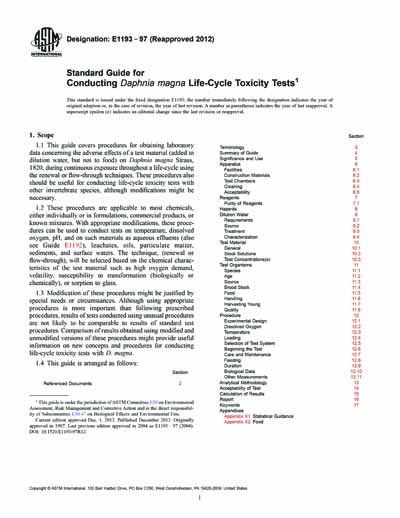Historical
ASTM E1193-97(2012)
Standard Guide for Conducting Daphnia magna Life-Cycle Toxicity Tests
1.1 This guide covers procedures for obtaining laboratory data concerning the adverse effects of a test material (added to dilution water, but not to food) on Daphnia magna Straus, 1820, during continuous exposure throughout a life-cycle using the renewal or flow-through techniques. These procedures also should be useful for conducting life-cycle toxicity tests with other invertebrate species, although modifications might be necessary.
1.2 These procedures are applicable to most chemicals, either individually or in formulations, commercial products, or known mixtures. With appropriate modifications, these procedures can be used to conduct tests on temperature, dissolved oxygen, pH, and on such materials as aqueous effluents (also see Guide E1192), leachates, oils, particulate matter, sediments, and surface waters. The technique, (renewal or flow-through), will be selected based on the chemical characteristics of the test material such as high oxygen demand, volatility, susceptibility to transformation (biologically or chemically), or sorption to glass.
1.3 Modification of these procedures might be justified by special needs or circumstances. Although using appropriate procedures is more important than following prescribed procedures, results of tests conducted using unusual procedures are not likely to be comparable to results of standard test procedures. Comparison of results obtained using modified and unmodified versions of these procedures might provide useful information on new concepts and procedures for conducting life-cycle toxicity tests with D. magna.
ASTM International [astm]

